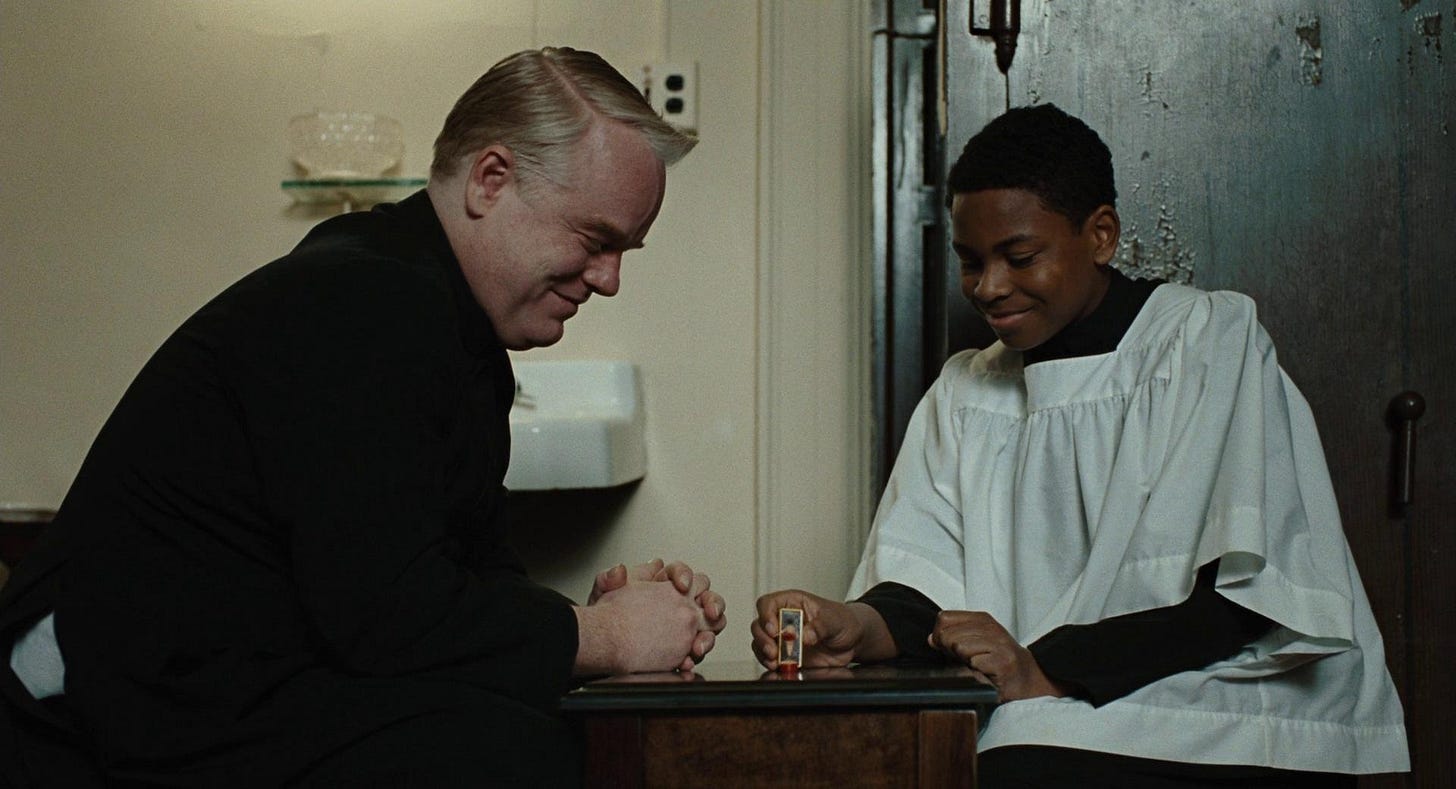Doubt (2008) A final farewell to Philip Seymour Hoffman (part 9)
“You can’t hold a child responsible for what God gave him to be”

Through the leaf filled streets of a late Autumn in the Bronx, New York, we follow a very eager and excited “Jimmy Hurley” (Lloyd Clay Brown) as he rushes to his local church to prepare for that day’s early morning sermon. Soon joined by fellow altar boy “Donald Miller” (Joseph Foster) as the boys organise in the bowels of the church, we cut to Jimmy’s parents approaching the church and a House of God already filling to capacity ahead of “Father Brendan Flynn” (Philip Seymour Hoffman) and his early morning homily. Pacing backstage, the boys pass the Father and into the packed church as director John Patrick Shanley settles on a long shot of the church, the nave his central point, and following an off camera “Be Seated” from Father Brendan Flynn, he commences his homily:
“What do you do when you’re not sure? That’s the topic of my sermon today”
Director Shanley moves his and our point of attention for the first time during this morning sermon or homily to the main congregation, hanging on every word from Father Brendan Flynn:
“Last year when President Kennedy was assassinated, who among us didn’t suffer the most profound disorientation? Despair?
Director Shanley returns to his main camera angle of the sermon, that of a close-up on Father Brendan Flynn:
“Which way? What now?”
A rolling close-up on members of the congregation now:
“What do I say to my kids? What do I tell myself? There was a time of people sitting together, bound together, by a common feeling of hopelessness”
A returning close-up of Father Brendan Flynn
“But think of that. Your bond with your fellow being was your despair”
Director Shanley now moves his camera for the first time over the shoulder of the Father, looking out at the packed congregation:
“It was a public experience. It was awful. But we were in it together”
A fuller and wider view of the entire church and congregation now:
“How much worse is it then, for the lone man, the lone woman, stricken by a private calamity?”
A returning close-up on the congregation:
“No-one knows I’m sick. No-one knows I’ve lost my last real friend…”
Back to a close-up on Father Brendan Flynn:
“…No-one knows that I’ve done something wrong. Imagine the isolation. You see the world through a window. On one side of the glass, happy, untroubled people, and on the other side, you”
Director Shanley now frames “Sister James” (Amy Adams) in close-up as she sneezes and is blessed by a young girl sitting beside her, before returning to a wider view from the congregation:
“I want to tell you a story. A cargo ship sank one night. It caught fire and went down. Only this one sailor survived. He found a lifeboat…”
A returning close-up of Father Brendan Flynn:
“…He rigged a sail, and being of a nautical discipline, turned his eyes to the heavens and read the stars”
We cut to a close-up of altar boys Jimmy and Donald:
“He set a course for his home, and exhausted, fell asleep”
We cut to a camera angle behind two Sisters in the congregation as one, “Sister Aloysius Beauvier” (Meryl Streep) begins patrolling the outside of the aisle:
“Clouds rolled in. For the next 20 nights, he could no longer see the stars. He thought he was on course, but there was no way to be certain”
A returning camera angle from an enraptured congregation:
“And as the days rolled on, and the sailor wasted away, he began to have doubts”
Sister Aloysius Beauvier admonishes a group of boys and girls talking through the Father’s homily, slapping one boy on the back of his head:
“Had he set his course right? Was he still going on towards his home?”
Another returning camera angle from the congregation:
“Or was he horribly lost? Doomed…”
Sister Aloysius Beauvier awakens a sleeping boy, ordering him to sit up straight and listen to the homily:
“…to a terrible death? No way to know. The message of the constellations, had he imagined it because of his desperate circumstance, or had he seen truth once and now, had to hold on to it, without further reassurance?”
Director Shanley returns to a close-up on Father Brendan Flynn:
“There are those of you in church today, who know exactly the crisis of faith I describe. And I want to say to you, doubt, can be a bond as powerful and sustaining as certainty. When you are lost, you are not alone”
Director Shanley returns to a camera angle from behind the Father as he finishes his homily with a prayer:
“In the name of the Father, Son and Holy Ghost, Amen”
“Please Rise”
We cut to Sister Aloysius Beauvier crossing herself as the church organ begins and a final cut to Donald watching a pigeon or bird, flapping against the inside of the glass domed roof of the church…
Based on the director’s 2004 Pulitzer Prize winning stage play Doubt: A Parable and nominated for 5 Academy Awards and 3 BAFTAs in 2009, both the film and play rests on two words found within Father Brendan Flynn’s opening homily and the first of three that provide the backbone to this wonderful film: “Doubt” and “Certainty”. For there is significant doubt as to the guilt of the accused and whilst there is next to zero proof, there is absolute certainty, and therein lies the beauty of the film: Without proof, do you believe the proclamations of innocence or do you follow the courage of the convictions of one person absolutely certain of another’s guilt? On opposing sides of this cinematic argument we find Meryl Streep and Philip Seymour Hoffman (both Oscar nominated for their portrayals here) butting heads (showcased brilliantly in a thunderous elongated scene as the film draws to a conclusion) and very much the old and the new of the modern church ethos of the early to mid 1960’s. Whereas Sister Aloysius Beauvier is a taciturn, cold and always watching matriarch figure and Principal of the school associated with the church, Father Brendan Flynn appears far more inclusive of the wider New York society around them and progressive, forward thinking, full of fun, and a smile never far from his face. Caught in the middle of their on going feud is Sister James (and Amy Adams completing a hat-trick of Oscar nominations for the film thus far) and although seen as an “innocent person” by Sister Aloysius Beauvier, she’s also used as somewhat of a spy in the camp and her smiling, desperate to please nature taken advantage of by the older and more senior Sister. The three share another of the film’s thunderous scenes at the mid-way point, and not even a constantly ringing telephone can break the unbearable tension building as accusations are made, doubt cast, and guilt evidenced as human certainty. The final two Oscar nominations fall to Viola Davis for her one scene of utter heartbreaking brilliance and director John Patrick Shanley for his adapted screenplay for a slow burning film where you’ll find no catharsis, little guilt, a lot of doubt, and a whole host of well meaning certainty.
This was my first viewing of Doubt and I loved it from first minute until last.
Highly recommended.
Thanks for reading. I hope this message in a bottle in The Matrix finds you well, prospering, and the right way up in an upside down world.
Whilst you’re here I may as well brag about the release of my trilogy of recently self-published books. Beautiful covers eh! As the title(s) would suggest, this is my life at the movies or at least from 1980 to 2024, and in volume 1 you’ll find 80 spoiler free appraisals of movies from debut filmmakers, 91 of the very best films appraised with love and absent of spoilers from 1990–2024 in volume 2, and in volume 3 you’ll find career “specials” on Paul Thomas Anderson and Quentin Tarantino together with the very best of the rest and another 87 spoiler free film reviews from 2001–2024.
All available in hardback and paperback and here are some handy links:
"A Life at the Movies Vol.1" - link to Amazon
"A Life at the Movies Vol.2" - link to Amazon
"A Life at the Movies Vol.3" - link to Amazon





